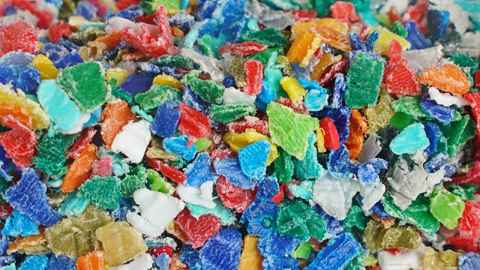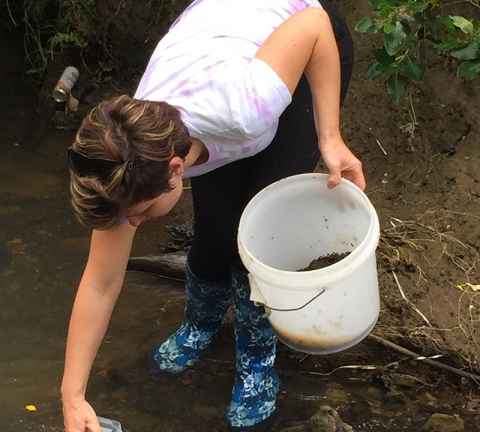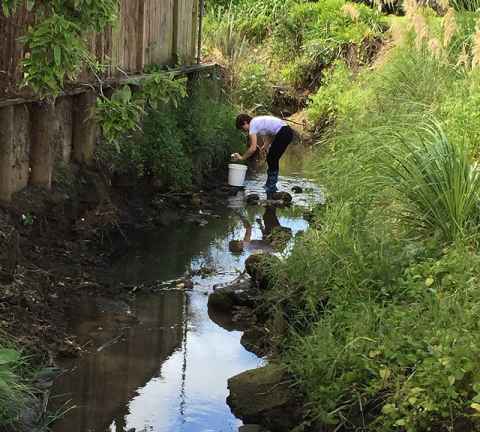A world made of plastic
3 December 2018
Plastic – as a fully synthetic, commercially successful substance – was invented by Leo Baekeland in 1907. In just 111 years plastic has not only been used in a multitude of products worldwide, it has also become an increasingly unavoidable environmental issue.

Despite efforts to recycle plastic, its durable nature and slow degradation has led to mountains of waste, and the presence of microplastics in our food chain.
These tiny fragments enter the food chain via freshwater and marine ecosystems quite easily, because you cannot always see them and they are the right size for organisms to eat.
In October, a national team of 18 scientists was awarded an MBIE Endeavour Fund grant of $12.5 million to conduct a five-year research project exploring the impacts of microplastics on New Zealand.
Under the auspices of the Institute of Environmental Science and Research (ESR), the team is led by Dr Olga Pantos (ESR) and Dr Grant Northcott (Northcott Research Consultants) and includes top researchers from Scion, the Cawthron Institute, the University of Canterbury and the University of Auckland.
Each team member is responsible for different steps in the project, but together they will apply their expertise to determine if microplastic contamination poses a risk to New Zealand’s unique ecosystems. The project includes a social science and Vision Mātauranga component and is guided by an advisory panel of experts. It will run until October 2023.
Seven University researchers from the Faculty of Science are involved:
- Associate Professors Kevin Simon and Giovanni Coco, and Dr Melissa Bowen from the School of Environment
- Dr Gavin Lear from the School of Biological Sciences
- Dr Louis Tremblay from the School of Biological Sciences and the Cawthron Institute
- Dr Xavier Pochon and Dr Anastasija Zaiko from the Institute of Marine Science and the Cawthron Institute
Associate Professor Kevin Simon says that microplastic is a popular issue with the public and the number of studies addressing plastic is growing exponentially, as researchers focus more on plastic pollution.
Associate Professor Giovanni Coco agrees that wherever you go, people want to know how much microplastic is being accumulated – and where.
“It’s normal to want to know these things because the problem with microplastics – and the reason why we are all worried – it that it is starting to enter the food chain. That is the issue and because not a lot of work has been done we have to attack it from all sides to grow our understanding.”
Along with colleague Dr Melissa Bowen, they will be focusing their components of the project in Auckland, primarily because of the strong link between the city and marine environment, and the hundreds of streams within Tāmaki Makaurau that flow into estuaries and on to the ocean.
“There is a very big knowledge gap in documenting what plastic is in our freshwater and marine ecosystems in Auckland,” Melissa says.
“We need to be thinking about who is producing it, where you find it, where it is ending up, and how it is affecting different parts of our environment.”
Plastic is a wonder substance, really, it’s hygienic and it’s waterproof. There are a lot of advantages to using it, you just have to figure out how to use it wisely.
Working as a team
Melissa and Giovanni will concentrate on the accumulation and distribution of microplastics in the Waitemata Harbour. They are building hydrodynamic models – mathematical models based on measuring real water flow – to figure out where the microplastic is coming from, how the water is moving microplastics around and where they are going.
We are looking at the ‘near field’, as people think a lot of the plastic is not going very far, and instead coming right back onto the shore,” Melissa explains. “We hope to find out if this true.”
Melissa will be doing all the measurements and will ‘ground-truth’ the model. Then Giovanni will develop the set of equations that will create the model and describe how water moves. The modelling component of the work will be supported by a PhD student before it is tested and validated.
Another PhD student will work on a different component looking at more of the ecological effects of plastic and the ecotoxicological implications for freshwater biota, as well as food webs and what kinds of microplastic organisms are ingesting.
“It’s a multi-faceted question,” Kevin says, “but we are intending to tease that apart by working with individual species in the lab, testing the effects of different types of microplastics and plastic contaminants, and what happens when organisms consume them.”
Work will start in simple laboratory systems at Cawthron and the University of Auckland, then shift to the Auckland Ardmore Field Station where they can create artificial ponds to replicate different treatments and environmental conditions. Tests will expose individual species to different plastics – with and without other contaminants.
“Eventually we want to scale it up to more complex systems in which we will have not just single species but everything from algae up to fish – entire mini-ecosystems – so we can run more intricate experiments,” Kevin explains. Other components of the Endeavour project involving faculty researchers include: investigating microplastic-associated microbes and their role in biodegradation (Dr Gavin Lear); whether the plastisphere poses a biosecurity threat (Dr Xavier Pochon and Dr Anastasija Zaiko); and assessing the toxicology responses of organisms exposed to microplastics and their associated contaminants (Dr Louis Tremblay).

Meeting some of the challenges
Melissa and Giovanni are anticipating a number of challenges as they work out how to create a realistic model that simulates the flow of microplastic through an estuarine environment.
“There is some uncertainty around how we work out how water would carry and disperse microplastic film and fibres,” they say. “We need to find a way to measure it accurately and have results that are sensitive enough to accommodate changes in the model so that it can be applied in different locations.”
One of Kevin’s initial challenges is simply where to start, because the research is still new and there are a lot of variables to deal with, like finding out which plastics are causing the biggest problems.
“There are all sorts of different plastics, different sizes and chemical formulations, new versus weathered plastic, lots of different contaminants that can be absorbed onto them and certain types of plastics may release chemicals in certain conditions,” he says.
“Once we find out what types of microplastic we actually see in places, and what types organisms ingest or interact with, we can use that information to develop our toxicity tests in the lab.”
An overarching challenge facing all researchers is the speed with which this field of research is rapidly changing and advancing.
“A big chunk of what we are doing is trying to come up with standardised methods, so that what we do across all the lab groups in this project is consistent, but is also internationally compatible and up to date with emerging technologies,” Kevin explains.
Giovanni adds, “There are many interesting projects going on in many countries. For example, researchers at the University of Sydney are looking at video imaging and detection technology that will distinguish between sand and microplastics in the water.
“And there is a lot of willingness to share knowledge. We need to meet and discuss our work as an international network of microplastic researchers, so we can advance things together, rather than separately.”

What more can we do?
The issue of plastic and microplastic, and what to do about both, is extremely complex.
“At the moment we cannot answer the questions that people are asking us,” Kevin says. “We are in the difficult position of supposedly being ‘the authority’, but we haven’t done the work, so we can’t provide the answers.
“By taking full advantage of the funding that is available for plastics research and building the evidence-based body of knowledge around microplastics, hopefully we will be able to tell people ‘we should not use that stuff’ or ‘it’s not a problem’.”
The trio envisage that when their components of the project are complete they will have contributed to the methodology to model microplastic accumulation and dispersion patterns in our environment and support local authorities to regularly monitor microplastics in their waterways.
“If we find out certain types of plastic are a big problem, then we will have the methods and information to guide environmental or food safety testing, for example,” Kevin says. “Or maybe – through our research on microbes – we will find organisms that can degrade plastics, or develop technologies that can accelerate plastic degradation.”
Our Endeavour researchers believe solutions are always going to involve a combination of approaches:
- Good filtering systems to capture microplastic before it enters our waterways
- Clean-ups targeted towards the source of microplastic in streams, rivers and estuaries
- Avoiding using certain kinds of plastics, and certain kinds of plastic compounds once we know they are problematic
- Biodegradable options, such as paper, to replace single-use plastic items
“Getting rid of shopping bags is great,” Kevin adds, “But maybe we’ll find out we are focusing on the wrong plastic and some other type of plastic is more of an issue.
“That’s part of what we want to find out: which microplastics are causing the problem. Because we are not just going to stop using every type of plastic right away. It is going to take time.
“In the long term, it’s about making smart decisions about what plastics we choose to use and how we deal with microplastics.”
There are other research projects focused on microplastics taking place within the Faculty of Science. In 2017, the George Mason Centre for the Natural Environment awarded funding to ‘Plastic pollutions and solutions’ – a project studying the impact of microplastics and associated chemicals that leach from plastics products – involving Associate Professor Kevin Simon, Dr Gavin Lear and PhD candidate Nadia Dikareva. More recently, Dr Julie Hope from the Institute of Marine Science was awarded a 2018 Marsden Fund grant for ‘The sticky link between microalgae, biofilms & microplastics: An interdisciplinary approach to understand the resuspension and transport of microplastics’.
inSCight
This article appears in the December 2018 edition of inSCight, the print magazine for Faculty of Science alumni.